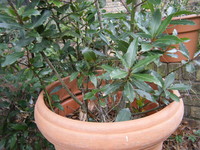Is there any pot of spaghetti sauce simmering on the stove top anywhere in Baldwin County that is not made oh-so-much better by the addition of the fragrant, fresh leaves of the bay laurel? …
This item is available in full to subscribers.
Please log in to continue |


Is there any pot of spaghetti sauce simmering on the stove top anywhere in Baldwin County that is not made oh-so-much better by the addition of the fragrant, fresh leaves of the bay laurel? Chefs and cooking aficionados swear that bay leaves are essential to preparing not only fine, old world tomato sauces, but make a savory addition to soups, stews, gumbo, roast chicken and pork and seafood boils.
Bay trees were seen by the herbalists of old as trees of virtue, which resisted witchcraft very potently. These tough, fragrant and useful evergreen plants with their green elliptical leaves were supposed to protect us from devils, witches, thunder and lightning - so, it would seem obvious, that no garden should be without at least one!
The bay leaf refers to the aromatic leaves of several plants used to add a rich depth to cooking. The bay laurel (Lauris nobiles) provides us with its fresh or dried leaves that are prized for their distinctive flavor and fragrance. After imparting their essence to the cooked dish, the leaves should always be removed before serving. The leaves do not break down during cooking, and, if eaten, can end up as shards that can puncture the mouth or throat.
The bay is an evergreen shrub or tree that is native to the Mediterranean area. Early cooks used it to flavor their cuisine, as well as for medicinal properties. Leaves fresh from the plant are quite mild and do not develop full flavor until several weeks after picking and drying Some of the bay leaf plants include bay laurel, California bay leaf, Indian bay leaf, Indonesian bay, West Indian bay and Mexican bay. They are similar in taste, but vary according to degree.
Bay leaves were used as flavoring by the ancient Greeks and are a common seasoning in European, as well as American cuisine. The leaves flavor many classic French dishes, where they are often used whole or as a flavorful bouquet garni with other herbs that are removed before serving. Bay leaves can also be crushed or ground before cooking. Crushed bay leaves impart more flavor than the whole leaves, but can be more difficult to remove.
If one should venture to taste a bay leaf, they would be startled by a pungent, sharp bitter taste. As with many spices, the fragrance of the bay is much more pleasant than its taste. When dried, the herbal fragrance is slightly floral and somewhat similar to oregano and thyme. Although culinary bay leaves can be eaten without toxic effect, they do remain stiff after cooking and, if swallowed, could scratch the digestive tract or cause choking.
While true, the bay leaf does not typically encourage drama with their dull green leaves, their flavor can impart a sensual, earthy, floral, minty, cinnamon note - hard to describe, subtle yet assertive.
Bay laurel leaves have been used by spice giant McCormick and Co. as one of its top 25 products for many years. Their taste testers describe the bay as a "foundational" flavor that can make a bland dish sizzle. With a sweet and heady perfume along with a note of spicy nutmeg, dried leaves are stronger than fresh. Crushing the leathery, stiff leaves releases the aromatic oil that is the source of the distinct flavoring.
Bay leaves can also be used scattered about the pantry to repel meal moths, flies, roaches, mice and silverfish. The leaves also discourage the growth of molds. Bay has also been a traditional medicinal plant, with uses as a treatment for earaches, rheumatism and as an insect repellent. The leaves can be used to make attractive and fragrant wreaths and garlands. In ancient Greece, the leaves were once fashioned into a wreath which crowned the winners of the old games.
I have not bought a bay leaf from the grocery store in years. When I need one, I simply step out onto my patio and pull one or two from my bay laurel tree, which has resided in a large clay container for about 12 years now. It stays on our patio unless a serious freeze threatens and then we bring it indoors. It thrives with little attention and produces a flush of new leaves each spring. The only pruning that I have done is when I pluck the fragrant leaves to use in my kitchen or share with family and friends. For the most part, it is pest free and we enjoy the leaves year round. I have become something of a bay snob - the dried leaves in cans or jars just can't match the flavor and fragrance of my own fresh shrub.
Bay plants are slow to start from both seeds and cuttings, so the quickest way to get one is to buy it at a local nursery. Due to this difficulty in propagation, bay is more expensive than other herbs, but it is worth it. Remember, you will never have to buy a bay leaf again. Plant your new little bay in a sunny location in well-drained soil. It is well worth growing your own bay tree for both its ornamental value and the fresh, wholesome seasoning it provides.
Bay leaf plants are beautiful additions to anyone's garden and by maintaining your own, you will enjoy fresh and delicious bay leaves to use year round in your cooking.